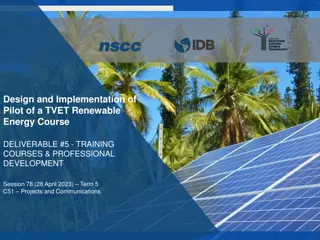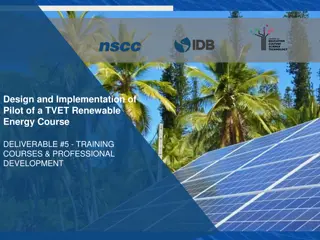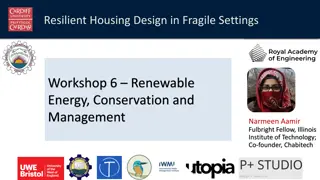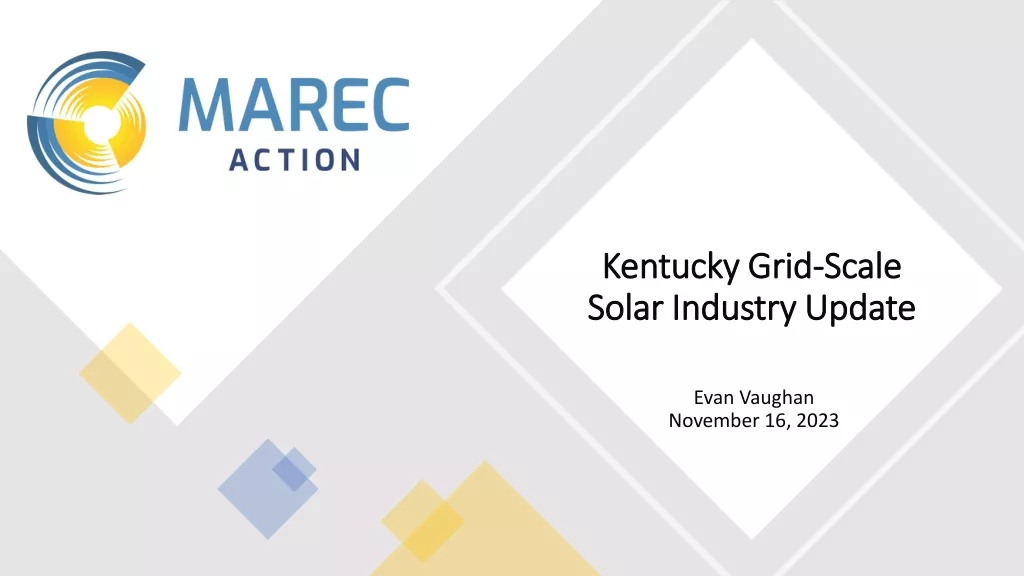Renewable Energy
These resources support practitioners in delivering renewable energy concepts for engineering and manufacturing qualifications at levels 2 and 3. Topics covered include sources of renewable energy, advantages and disadvantages, planning for renewable energy, delivery suggestions, energy calculations, wind and solar power utilization, and transitioning to a net-zero economy.
Download Presentation
Please find below an Image/Link to download the presentation.
The content on the website is provided AS IS for your information and personal use only. It may not be sold, licensed, or shared on other websites without obtaining consent from the author. Download presentation by click this link. If you encounter any issues during the download, it is possible that the publisher has removed the file from their server.
Presentation Transcript
Renewable energy 2. Planning for renewable energy
Practitioner guide 2. Planning for renewable energy 2
2. Planning for renewable energy | Practitioner guide Introduction and overview These resources help practitioners to deliver the renewable energy components of engineering and manufacturing-related qualifications at levels 2 and 3. They introduce the topic and stimulate learners to explore and reflect on key concepts and are designed to complement and enhance practitioners own lesson materials and schemes of work. Resources summary Prerequisites - We recommend that learners complete 1. Sources, advantages and disadvantages of renewable energy before starting this resource. Resource name Level PPT slides + notes practitioner PPT slides learner Activity sheets Film Interactive 2. Planning for renewable energy 3 3 Delivery Delivery suggestions for practitioners, and suggested answers where appropriate, are in the presenter s notes for each slide. The core activities in each resource provide around 60 mins of learning time, though additional suggestions, including independent learning, can extend this time significantly. The Level 3 resources explore making energy and power calculations and consider how solar and wind power can be combined to provide low-carbon power for a manufacturing plant, exploring seasonal variations, before making ballpark calculations for the UK. They explore how other emerging technologies can be implemented alongside renewables to create a smart distributed grid that is responsive to dynamic changes in supply and demand, and how learners engineering careers can contribute to the transition to a net zero economy. Overarching theme/big questions How can renewable energy meet current and future demand? Overview The Level 2 resource reviews the need for renewable energy as an alternative to fossil fuels that contribute to climate change and helps learners to consider some advantages and disadvantages of each form, and how they might help to power the UK. 3
2. Planning for renewable energy | Practitioner guide Learning outcomes and resource links Level 3 resource 1 Planning for renewable energy Full resource list available for the topic of Renewable energy: 1. Sources, advantages and disadvantages of renewable energy (Level 2) 2. Planning for renewable energy (Level 3) 3. Delivering renewable energy (Level 3) Make calculations about energy and power, for generation and use. Explain some key factors that influence the power output of a wind turbine. Links to other supported topics Use data and a simulation to make informed decisions about implementing wind and solar power generation for a manufacturing plant and for the UK. Battery technologies, Electrical machines, Innovation and emerging technologies, Sustainability. 4
2. Planning for renewable energy | Practitioner guide Subject coverage Maths Renewable energy Including careers Working with units Using formulas Energy, work and power Examples of career opportunities related to renewable energy and net zero technologies Energy from wind Seasonal variations in renewable energy Renewable energy mixes Balancing supply and demand Harnessing wind and solar energy in the UK 5
2. Planning for renewable energy 6
2. Planning for renewable energy Learning outcomes You will be able to: Use data and a simulation to make informed decisions about implementing wind and solar power generation for a manufacturing plant and for the UK. Explain some key factors that influence the power output of a wind turbine. Make calculations about energy and power, for generation and use. 7
2. Planning for renewable energy Energy, work and power What happens to the energy in this cylinder of moving wind? How efficient is the turbine? Energy is the ability to do work or to create heat or light. The kinetic energy in the wind makes the turbine blades move, but some energy is lost as heat. The kinetic energy in the blades is converted into electrical energy. Where do you think the heat losses occur? Heat losses 10% Wind 40% Wind 100% Electrical energy This Sankey diagram represents the energy conversion in the wind turbine. 8
2. Planning for renewable energy Energy, work and power Power is the rate at which energy is transferred. The unit of energy is the Joule J. The unit of power is the Watt W. 1 W = 1 J/s Energy E = Power P x time t Power P = Energy E Time t What factors affect the power output of this wind turbine? 9
2. Planning for renewable energy Calculating available wind power How can we calculate the potential power available from a wind turbine? Consider this cylinder of air with area A moving with velocity v. A The kinetic energy of the air is given by E = 1 mv2 2 v The mass m of the air is given by its density and volume V: m = V where V = Avt, the area x velocity x time. Hence E = 1 x x Avt x v2= 1 Av3t 2 Since power = energy/time this gives P = 1 Av3 2 2 However, Betz s Law states that a turbine can t use more than 59% of the theoretical power available in the wind. Give a qualitative explanation for why you think Betz s Law applies. What stops a turbine from using all of the wind power available? Complete the questions on your activity sheet to calculate the maximum power a range of wind turbines can produce at low and high wind speeds. Use = 3.14159. 10
2. Planning for renewable energy Calculating available wind power - answers In reality, the maximum output power is limited by the rated output of the generator in the turbine s nacelle and by the fact that real-world turbine designs can only approach 75-80% of the Betz limit. Real outputs are about of those in the upper limit column of the table. Example: Diameter 5 m/s wind (lower limit) 15 m/s wind (upper limit) 222 m 1,712,808 W 46,245,822 W P = 1 Av3 2 164 m 934,739 W 25,237,960 W = 1.2 kg/m 127 m 560,545 W 15,134,706 W For 1.2 m dia. blades at 5 m/s: 24 m 20,018 W 540,492 W 2 ( ) 3 m 313 W 8,445 W P = 0.5 x 1.2 x 1.2 x 53 2 1.2 m 50 W 1,351 W = 84.823 W (using 3.14159 for ) Applying Betz s Law: 0.59 x 84.823 = 50 W at 5 m/s, (rounded) 11
2. Planning for renewable energy How much energy or power do we need? Use E=Pt and P=VI to calculate the answers to these scenarios. When is this energy most likely to be needed during the day? What implications does this have for a renewable energy supply? Mobile phone Electric vehicle (EV) CNC machine Robot arm How long will it take to charge a mobile phone battery? How much energy can an EV battery store? How much average current does this CNC process draw? How much energy does this robot arm use? V = 3.7 V V = 400 V Energy = 14.9 MJ Time = 16 hrs Capacity = 3000 mAh Capacity = 90 kWh Time = 90 mins Voltage: 230 V Charger = 18 W Voltage = 230 V Average current draw: 10 A 12
2. Planning for renewable energy How much energy or power do we need? Demand varies with activities, which vary with time (for example EVs might be charged during the day at the factory) while supply from renewables is intermittent, depending on the weather and time of day. Mobile phone Electric vehicle CNC machine Robot arm To find the energy find the power consumption and multiply by time: To turn kWh into Joules: To convert from energy to power: The battery s capacity is: 3.7 V x 3 Ah = 11.1 Wh 1 kWh = 1000 W x 3600 s 14,900,000 J = 2759 W 90 x 60 s Power = 230 V x 10 A Charge time with an 18 W charger is: = 3.6 MJ in each kWh = 2300 W 3.6 MJ x 90 = 324 MJ Current = 2759 W 11.1 Wh x 60 mins 18 W 230V 2300 W x 16 hrs x 3600 s Note that the voltage is irrelevant here. = 12 A average current. = 132.48 MJ. = 37 minutes to charge. 13
2. Planning for renewable energy Renewable energy: exploring supply and demand The owner of this manufacturing plant wants to shift to renewables and is modelling their options. What can the model tell you about the opportunities and limitations for using wind and solar energy for this manufacturing plant? Add small or large wind turbines to the site. Explore how supply and demand change across the day and seasons. Add solar generation to the roof or a nearby field. Each box represents 10 x 1.6 m2panels. Identify when grid supply is needed or when excess energy is available, and how this affects the plant s carbon emissions. 14
2. Planning for renewable energy Renewable energy: finding the optimum mix Use the Renewable energy interactive tool to answer these questions: 1. What are the maximum power outputs for each of the following: one large turbine, one small turbine, one group of 10 solar panels (one box on the interactive)? Consider what time of day and year to select to identify these values. 2. What are the annual emissions savings for each of the following: one large turbine, one small turbine, one group of 10 solar panels? 3. Estimate the total annual emissions that can be saved when the site s demand is fully met by renewable energy. 4. When is the peak time for wind energy and for solar energy, within the time and seasonal options available? Consider what time of day and year to select to identify these values. 5. Why might three small turbines be chosen over one large turbine?* 6. The site is at the edge of an industrial estate with parking. Where else might the additional solar panels be located instead of in a neighbouring field?* 7. What is the maximum excess power that can be generated? 8. What could the site owner do with this excess power when it is available?* 9. What emissions could be saved by exporting this excess power for other users? *for these questions, use your knowledge to answer rather than the interactive tool. 15
2. Planning for renewable energy Renewable energy: finding the optimum mix answers 1. Maximum power outputs: a. Large turbine: 37 kW b. Small turbine: 11.1 kW c. 10 solar panels: 2.5 kW (250 W per 1.6 m2panel, or per 156 Wm-2) 2. Emissions savings: a. Large turbine 55.6 tonnes (the interactive averages outputs rather than using maximums) b. Small turbine 16.7 tonnes c. 10 solar panels 1.8 tonnes 3. Total emissions savings would be about 77 tonnes of CO2per year with 100% renewable energy. 4. The peak time for wind energy is winter at 3pm and for solar energy it is summer at 3pm. 5. Three small turbines might be chosen over one large turbine due to the visual impact or other planning constraints. 6. Additional solar panels might be located on parking verges, spare parking or yard space and other unused spaces with good sunlight. 7. The maximum excess power that can be generated is 15.9 kW, on a summer afternoon. 8. The site owner could install battery storage for some or all of this excess, or export it to the grid. This would allow carbon savings for the owner or for other electricity customers at times other than when most renewable energy is available. 9. About 10.7 tonnes of CO2emissions (87.7 - 77) could be saved by exporting this excess for other users. 16
2. Planning for renewable energy Powering the UK At current values: The transition to EVs and away from fossil fuel use means that electricity will provide almost all of the UK s energy needs by 2050. 1.6 m2solar panel typically provides 250 W per year. 1 kW solar typically produces about 850 kWh per year. It is anticipated that this will mean an increase in demand from around 300 TWh today to about 610 TWh in 2050, largely supplied by wind and solar generation. One offshore wind turbine produces 8 MW. Each 1 MW of wind capacity produces about 500,000 kWh per year. One scenario is to install the following generation by 2050: 430 TWh offshore wind 85 TWh solar What area of solar panels and how many wind turbines will be needed? (Nuclear, tidal, hydrogen and clean gas could provide the remainder.) 17
2. Planning for renewable energy Powering the UK - answers Solar generation by 2050 Wind generation by 2050 Requirement of 85 TWh = 8.5 x 1013 Wh Requirement of 430 TWh = 4.3 x 1014 Wh Remember that 1 kW of solar produces 850 kWh per year = 8.5 x 105 Wh Remember that each 1 MW wind turbine produces typically 500,000 kWh, so 8MW will produce Hence required capacity in kw of solar is 8 x 500,000 kWh = 4 x 109 Wh per year 8.5 x 1013 Wh = 1 x 108kW 8.5 x 105Wh Dividing total requirement by output per turbine gives 4.3 x 1014Wh = 1.075 x 105 4 x 109Wh A 1.6m2panel produces 250 W per year or 0.25 kW, so four panels per 1 kW. = 107,500 offshore wind turbines (each 8 MW) Hence 4 x 108x 1.6 m2of panels are needed = 640,000,000 m2solar panels This is 0.003 of the UK s land area, or about 90,000 Premier League football pitches. 18
2. Planning for renewable energy Learning outcomes You will be able to: Use data and a simulation to make informed decisions about implementing wind and solar power generation for a manufacturing plant and for the UK. Explain some key factors that influence the power output of a wind turbine. Make calculations about energy and power, for generation and use. 19

















































